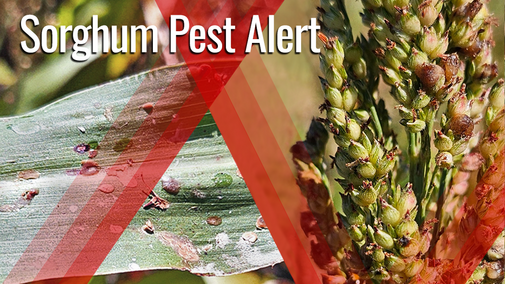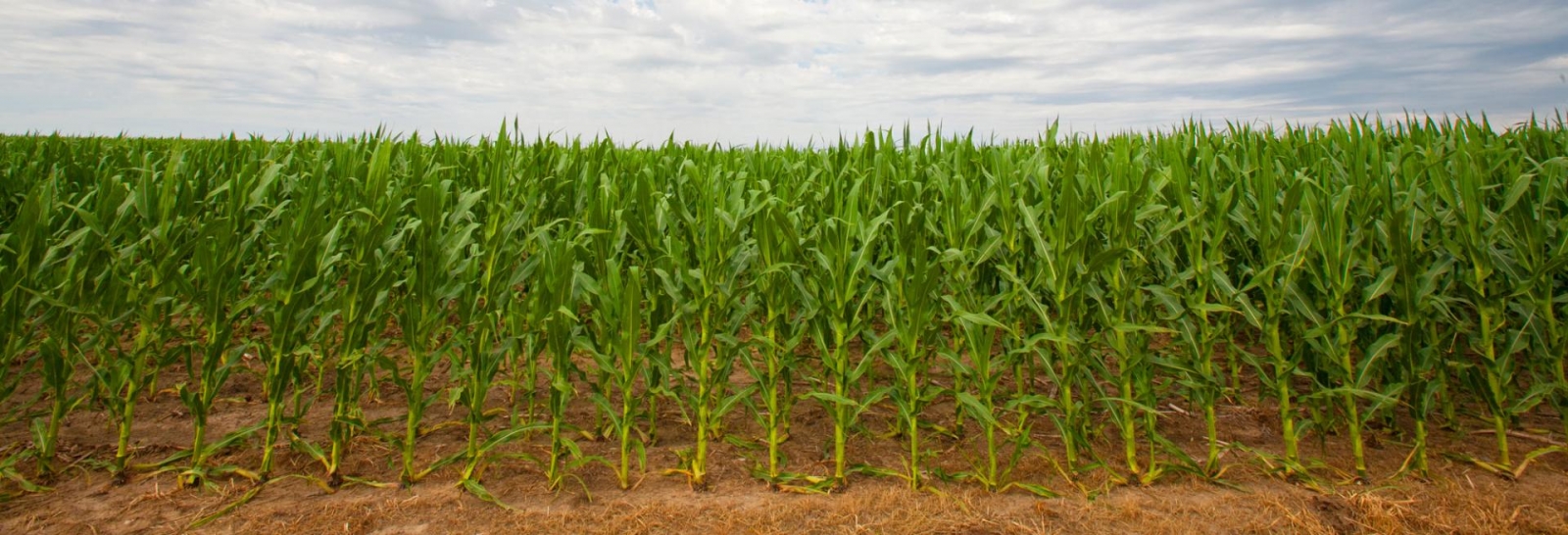Key Takeaways
Confirmed in Nebraska: Sorghum ergot has been confirmed by Nebraska Extension in forage sorghum this year.
Sticky honeydew symptoms: The disease produces amber honeydew on sorghum heads, which can cause moldy panicles and harvest complications. Waiting for rain or a freeze before harvest may ease handling.
No effective fungicides: Fungicide treatments are not effective at this stage; harvest management remains the best control option.
Low toxin risk: Alkaloid-producing sclerotia have not been observed in Nebraska since 1997, so toxin risk is considered low.
Report suspected cases: Producers should contact their local Nebraska Extension office or submit samples to the UNL Plant and Pest Diagnostic Clinic for confirmation.
A rare crop disease long confined to southern states is making an appearance in Nebraska sorghum fields, bringing potential harvest headaches along with it.
Wetter conditions and persistent southern winds have led to an increase in crop disease problems this season — including ergot in sorghum (Figure 1), caused by the pathogen Claviceps africana. The disease is common in the southern U.S., but rarely occurs in the northern Great Plains. The last time the UNL Plant and Pest Diagnostic Clinic confirmed sorghum ergot in the region was in 2014.
This year, sorghum ergot has been reported in both grain and forage sorghum in Kansas and, so far, in forage sorghum in Nebraska through preliminary surveys.
Identification and Symptoms
Sorghum ergot is not caused by the same pathogen responsible for ergot in wheat and rye (Claviceps purpurea), and it looks quite different. C. africana does not produce the large, dark sclerotia that replace grain in the heads.
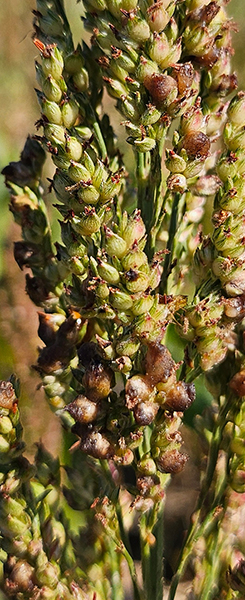
Instead, sorghum ergot fungus infects and fills the ovaries of sorghum flowers, preventing pollination, fertilization and seed production. The infection produces sticky, amber-colored “honeydew” droplets in the developing heads, which attract insects (Figures 2-3). The most noticeable symptom of the disease is the honeydew droplets, which often drip onto leaves or the soil, making the plant surfaces shiny or sticky when fresh, and leaving white to tan speckles as they dry.
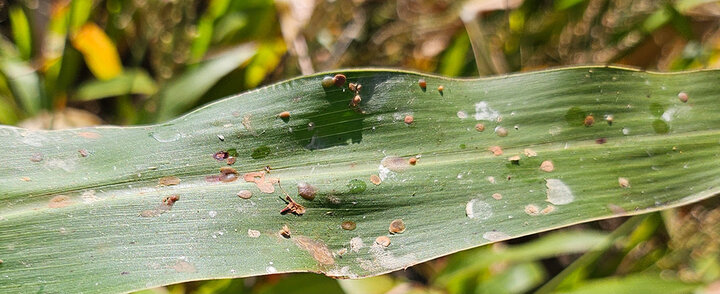
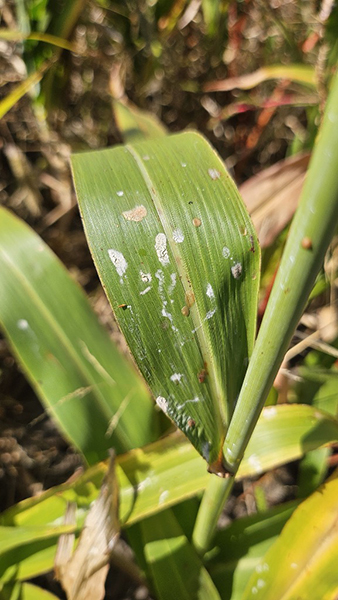
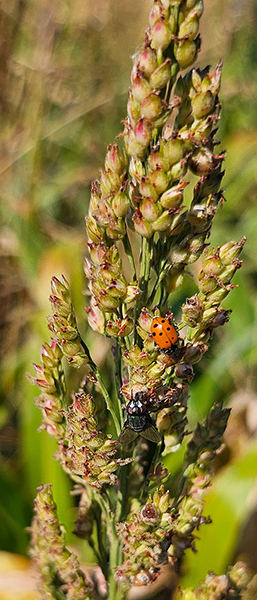
Within the honeydew are different types of spores that can be dispersed both within the field by rain and to other fields via wind. Wind-borne spores infect non-pollinated ovaries, converting them into a white, fluffy fungal mass called sphacelia.
Favorable Conditions
Honeydew production is more prevalent and visible during periods of cool, damp weather. Infection is favored when nighttime temperatures are 50°–55°F during pollen formation (two-three weeks prior to flowering) and at flowering, with moderate temperatures and high humidity favoring development of sphacelia.
Toxin Concerns and Feed Safety
The honeydew may affect the quality of grain and forage but is not associated with production of alkaloid toxin. This toxin is only produced in sclerotia — hard, black survival structures that develop in the fungal mass on heads. Sclerotia are typically only produced in Texas but have a small chance to occur in later-blooming, male-sterile forage sorghum or late tillers; sclerotia have not been confirmed in Nebraska since 1997.
Once honeydew production has stopped, there is little to no risk of sclerotia formation.
As the disease progresses, secondary fungi may colonize the honeydew, causing dark, mold-covered panicles (Figure 4).
Because sclerotia rarely occur in Nebraska, there’s currently little to no toxicity risk for affected sorghum used for livestock feed.
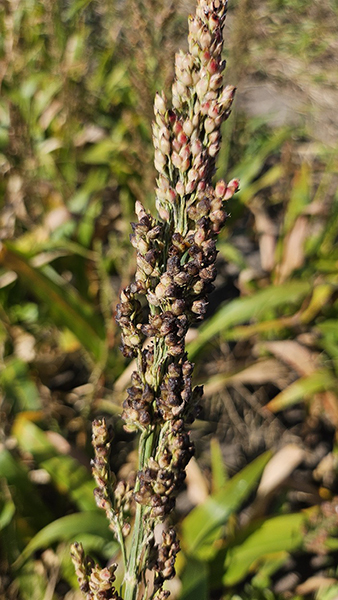
Susceptible Varieties
Sorghum varieties and fields vary in susceptibility, in part due to the timing and weather conditions during flowering. Male-sterile forage sorghum varieties are at increased risk for infection and are currently where most of the sorghum ergot has been identified in Kansas and Nebraska.
Sorghum ergot may also develop in Johnsongrass, shattercane and volunteer sorghum.
Management and Harvest Considerations
- At this point in the season, fungicide applications will not be effective.
- Harvest management is the most important consideration at this time, as sticky honeydew can cause grain or silage to clump together.
- Harvesting forage sorghums prior to heading eliminates risk of this disease.
- If infection is patchy in the field, keep the harvested grain or hay separate to allow for future testing.
- Honeydew can complicate harvest and handling for grain and forage, or lead to molding in baled hay or silage, reducing quality.
- Delaying harvest until after rain or a freeze can help reduce the amount of honeydew on the plant and make harvest easier.
- If there is concern about alkaloid contamination, some laboratories offer testing services. The Veterinary Medical Diagnostic Laboratory at the University of Missouri currently offers testing for ergot alkaloids in both grain and forage.
- If you have questions or suspect sorghum ergot in your fields, please contact your local Nebraska Extension office and submit samples to the UNL Plant and Pest Diagnostic Clinic. Please include a completed sample submission form when sending samples.
For More Information
- UNL Sorghum Ergot Factsheet, https://cropwatch.unl.edu/plant-disease/sorghum/ergot/
- United Sorghum Checkoff Factsheet: Sorghum Ergot – FAQs, https://www.sorghumcheckoff.com/agronomy-insights/sorghum-ergot-frequently-asked-questions/
- Nebraska Extension offices statewide can assist with sample submission and management advice.
